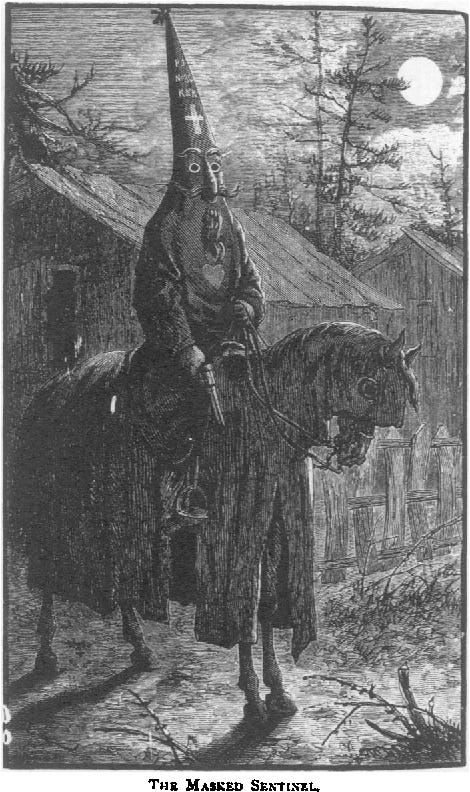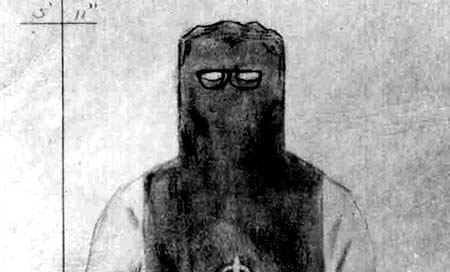Many readers may be familiar with the ‘Zodiac killer’, a serial killer active in northern California in the late 1960’s. A victim who survived one of Zodiac’s attacks described to police what his attacker looked like, resulting in the following sketch:
The most obvious and important element of this costume is, of course, the hood.
It is easy to take it for granted, but the face is the focal point of communication in real world social interactions. Words are spoken from the mouth and feelings and tone are equally conveyed through facial expressions. The face is the most recognizable and important external component of one’s identity.
The function of this hood, then, is to hide the face—to make Zodiac unrecognizable. It is a mask.
Killers risk reprisal. Concealing one’s identity while committing such a violent act is a common strategy cross-culturally.
Some practices I have touched on in previous articles:
The ‘Kurdaitcha’ costume to pin a killing on the malicious ‘Kurdaitcha’ spirit among the Arunta of Central Australia. The Assassins Footprint.
The hangahiwa wandafunei [violent spirits] that men would embody when comitting a secret killing among the Ilahita Arapesh of New Guinea. Notes on Nggwal.

Note that in the Zodiac costume shown further above, the circle-cross symbol is given a place of prominance on the chest of the killer, at the bottom of his hood. This, coupled with his phone calls and letters to the media indicate that while Zodiac wanted to conceal his ‘true’ identity, he desperately wanted credit given to the ‘Zodiac killer’ identity he constructed.
Relatedly, Tuzin notes of the hangahiwa wandafunei entities that,
when an ordinary man dons one of these costumes he feels the "heaviness" of the mask, and the indwelling spirit(s) transform him into a compulsive killer; his own child or brother would not be spared if he came upon them. To this extent, the men are not entirely deceiving the women when they tell them that the hangahiwa are spirits incarnate.
There are also the ‘human-animal societies’ of West Africa, where animals such as leopards, baboons, and crocodiles were impersonated by secret societies and even opportunistic individuals, to misdirect responsibility for their own attacks. Leopard Society and the Man-Leopard Murders.
Another case concerns the ‘bear doctors’ of native California. Anthropologist Samuel Barrett wrote in 1917 that, “one of the most concrete and persistent convictions of the Indians of a large part of California is the belief in the existence of persons of magic power able to turn themselves into grizzly bears.” This belief is not simply a myth but is thought to reflect an actual practice of ‘bear doctors’ disguising themselves as bears while attacking another person.
Anthropologist Alfred Kroeber describes the common perspective on these ‘bear doctors’ or ‘bear shaman’ across many native Californian tribes, writing that,
The grizzly bear shaman's activities are reported on by the Pomo much as by the Yuki and Maidu. Incased in a complete bearskin, his body wrapped with belts of beads serving as armor, and with a horn dagger concealed on him, this nefarious being roamed the hills in search of his human prey, not sparing even people of his own town, if he owed them the least grudge or if their spoliation seemed sufficiently profitable.
The costumes of the Klu Klux Klan are also relevant here. Elaine Frantz Parsons writes that, “Klansmen frequently claimed to be ghosts of the Confederate dead; this was probably Klansmen’s most popular disguise. They often claimed to have returned to earth by way of hell.”

Witnesses to Klan attacks also sometimes reported them wearing women’s clothes and blackface.
There are many more cases and much more to be said on this topic, but for now two key dimensions to the use of homicide disguises that I see:
The concealment of one’s own true identity as the perpetrator.
Misdirecting responsibility for the act onto another agent.
Killings are often pinned on violent ghosts or spirits, aggressive beasts, and other figures or groups that can be safely scapegoated.






